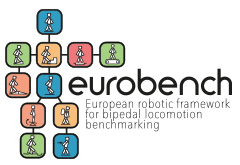| CASE SCENARIO 1: PROSTHETICS |
| SOLIDUS, a prosthetic manufacturing company has been working on development of its powered ankle prosthesis CLAW for more than a year. The current prototype has been structurally tested to pass both ISO 10328 and ISO 22675 tests. In order to assess the biomechanical behaviour of the device, SOLIDUS has decided to have the CLAW tested at the newly opened EUROBENCH Wearable Robots Facility in Spain as this service seems to be both technically relevant and affordable. Results from the series of tests show that the device scores well (8.5/10) on hard surfaces and ascending slopes and stairs, but on softer surfaces and descending slopes the score is about average (5&5.5/10). The EUROBENCH software, based on systems previously tested, suggests that the use of ground reaction force as a control time point is not optimal in these situations.
Going back to the lab, engineers at SOLIDUS found a different way (patent has been applied for) to control the device addressing the situations where the device was not performing well. Retesting the CLAW at EUROBENCH showed that the device scored the same as before on the hard surface and ascending but the score on soft surface and descending slopes had improved considerably (7.5&8/10). Based on these results, the SOLIDUS company has now reached marketable TRL for this new powered ankle in considerably shorter time than using conventional testing methods. First sales of the CLAW reveal high interest from the market, partially based on the on the high level of supporting evidence available, thanks to the EUROBENCH framework. |
| CASE SCENARIO 2: EXOSKELETONS |
| ExoLab, a spin–off company of the University of Belgrade, aims at developing an innovative exo-suit for the assistance of lower limb functions for stroke people. Before starting the development, they want to perform an analysis on the state of the art of current robotic exo-suits, to identify clear design requirements. Unfortunately, they found very difficult to identify the system ability levels of existing solution by reading published papers.
At a certain point of development, they hear about the EUROBENCH Software and decide to employ it to look at the system abilities levels of other solutions. They find that three exo-suits were previously tested with the EUROBENCH framework, and they can find detailed results stored in its database. One of these exo-suit reached particularly low scores (2/10 and 3/10) in interaction ability and human-like motion ability. The analytics algorithms embedded in the software established a potential causal relation with the adopted sensor technology (low-resolution encoder) and the actuation system (pneumatic). Following these indications, ExoLab developers modify immediately the sensory and the actuation technology thus increasing the safety and performance of the device and avoiding potential issues in their real prototype and expensive trial-and-error procedures. |
| CASE SCENARIO 3: HUMANOIDS |
| EMEI is an Italian multinational corporation dedicated to the development and management of renewable energy around the world. In particular, it has in total more than 800 hydropower plants in Italy with capacity over 11 GW, where inspection and maintenance tasks are intensively required.
Since the environment inside the power plant is designed only for humans (stairs, grate floor, ladders, etc.), EMEI has decided to employ a humanoid robot which is capable of excellent locomotion in tough and uneven environment. The EUROBENCH Humanoids Facility in Italy provides the benchmark results for the hardware specification and locomotion and balancing control performance of one selected humanoid candidate. Owing to the well-categorized benchmark scores, it is identified that the control algorithm for the locomotion on the slippery floor must be improved by more than 30%, which is one of special requirement for operation in the hydropower plant. After this benchmark, the researchers carry out test trials with their prototyped algorithms in the EUROBENCH facility. The results from the benchmarks based on EUROBENCH protocol are recorded in the database with different protection-levels of confidentiality and availability; making possible to comparatively validate the results with other open-sourced data collected in the facility. |
| CASE SCENARIO 4: INNOVATIVE SENSING SYSTEMS |
| SENSIT, a small, Irish company has been working on the development of sensors to measure pressure and shear forces to measure human-robot physical interaction in a reliable way for exoskeleton and prosthetic devices. A prototype has been made, but further development is needed to finalize the design and validate it.
The company became aware of a call for proposals from the EUROBENCH project and decided to apply for a grant through the FSTP-1 Open Call. The proposal was successful and SENSIT was granted 100k€ to develop and test the new sensors. This acceptance also triggered a matching local grant so SENSIT now had 200k€ to work with. SENSIT was able to finalize the design and validate the sensors in the EUROBENCH platform. The results showed that the sensors were reliable and provided a novel way to measure human-robot interaction ability. The sensor was included in the EUROBENCH facility for wearable robots, and a corresponding test protocol was written. As the sensor is quite simple to use, it can also be used outside the test facility, and SENSIT is now offering the sensors as a stand-alone device. Thanks to its use in the EUROBENCH test centre, the sensors have gained commercial visibility from potential customers, such as test labs and companies, which have started to buy them for quick reference measurements based on the EUROBENCH protocol. |
